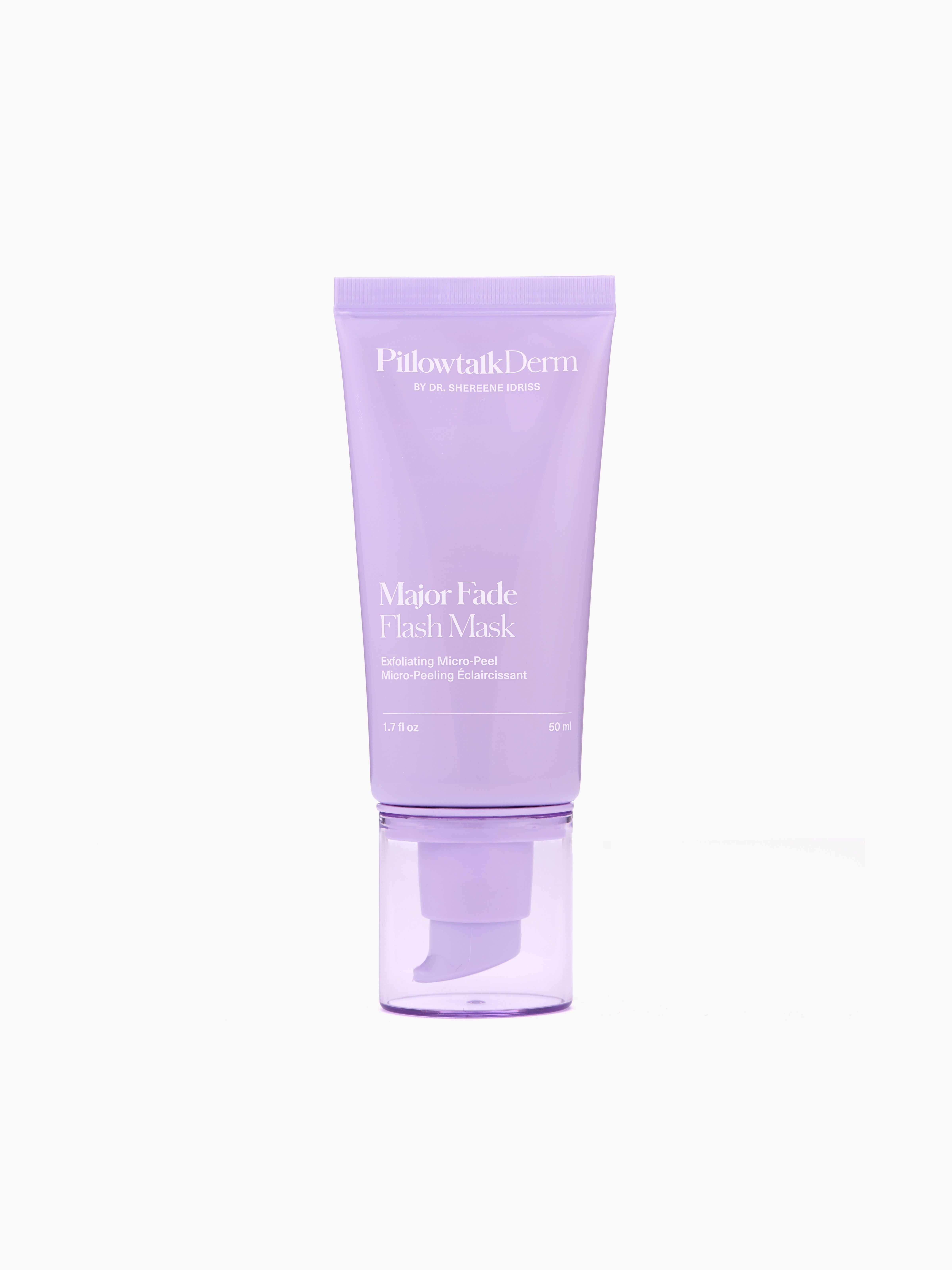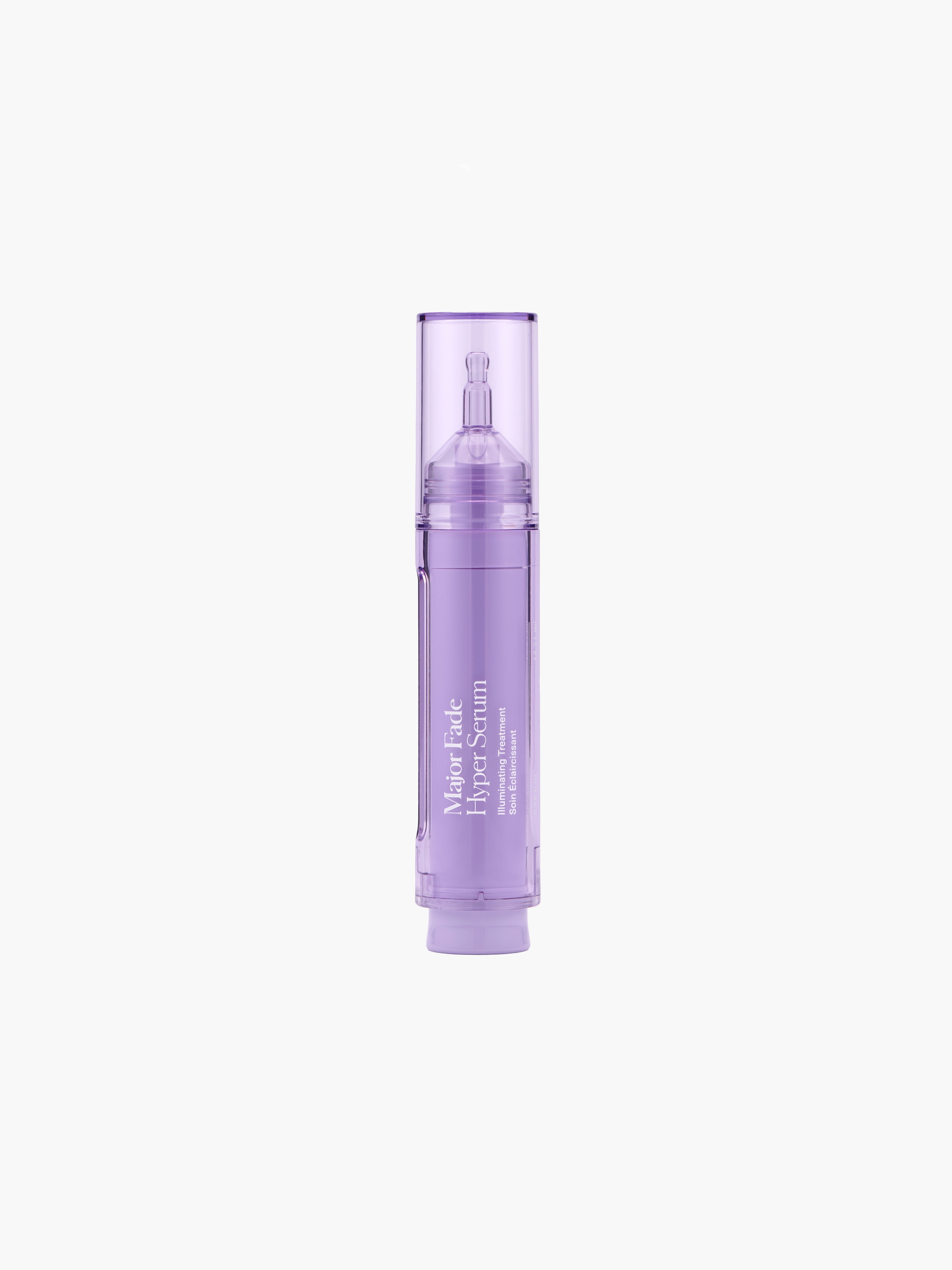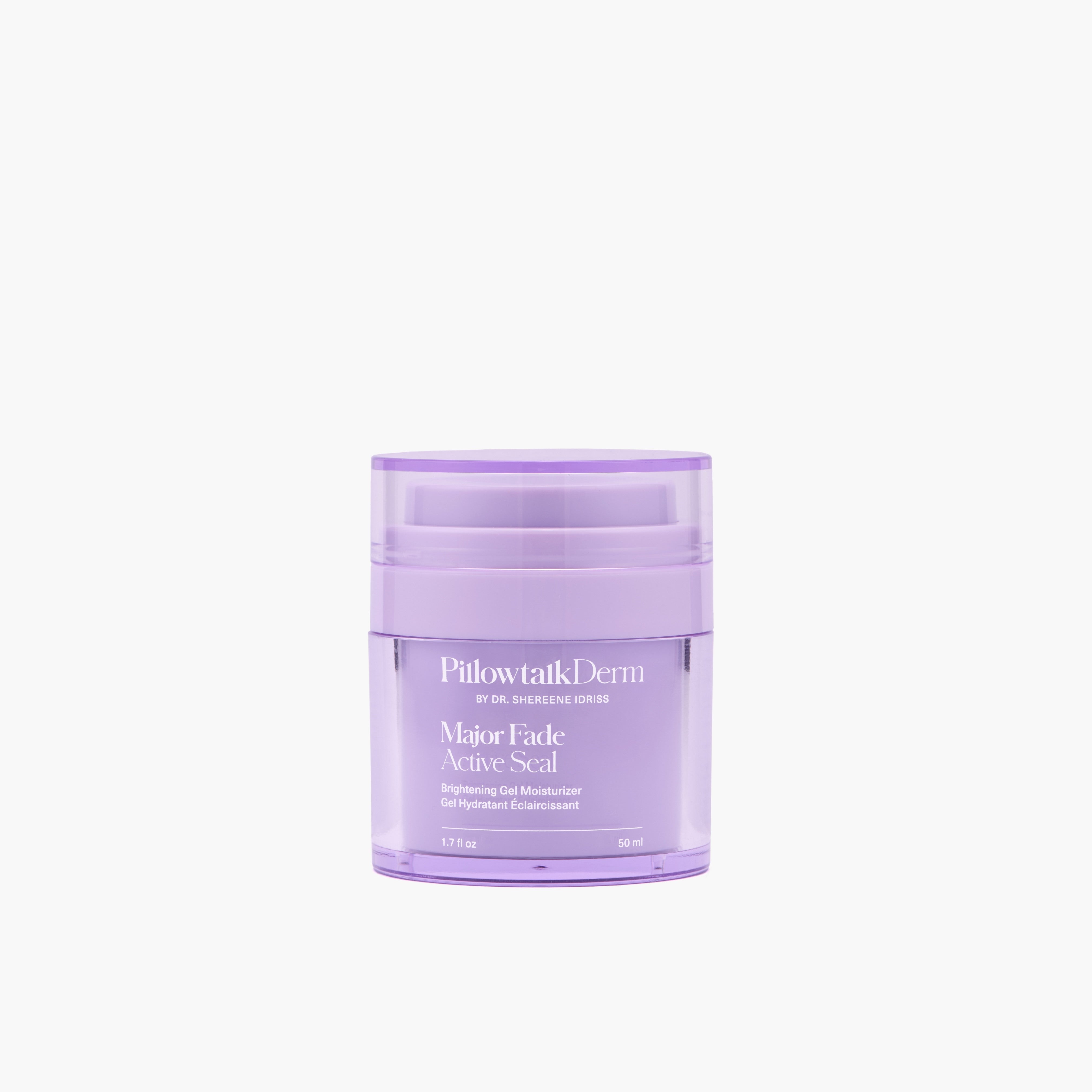How The #PillowtalkDerm Deals With Uneven Skin Tone
Dr. Shereene Idriss, aka The PillowtalkDerm
Whether she's talking to Harper's Bazaar, The Cut, Gloss Angeles, or directly to her 441k Instagram followers, Dr. Shereene Idriss, also known as the #PillowtalkDerm, is constantly answering questions about melasma and how to treat it.
She's honest, too. "Melasma is a little bitch," she says — because it's personal. Over the last few years, dealing with her own severe and "depressing" postpartum melasma, Dr. Idriss made it a life goal to figure out "the best f-ing treatment." Now, she has her own skin-care line, PillowtalkDerm, that bottles up everything she's learned about how to treat discoloration with the a cocktail of brightening ingredients that don't require a prescription.
AdvertisementADVERTISEMENT
On the common causes of melasma
Like acne, discoloration is tricky. "Anyone who has melasma will tell you that it's impossible to predict," says Dr. Idriss. Many people experience melasma, dark spots, or post-inflammatory hyperpigmentation (when your skin produces extra melanin when it's been irritated) after prolonged sun exposure. Though unfortunately, even if you're wearing sunscreen all the time, you can still experience unwanted pigmentation. "Heat, like from hot yoga, or stress, hormone fluctuations, going through infertility treatments or IVF, pregnancy — can all cause flares in pigmentation," Dr. Idriss explains.
For Dr. Idriss, melasma came after giving birth to her son back in 2019 — and it was psychologically damaging. "I'm a skin-care person who has always taken care of their skin," she says. "But the day after I popped him out, [I had] melasma. I looked like The Crypt Keeper overnight." Which was a problem, as she had built her #PillowtalkDerm community through face-to-camera videos. "I wouldn't even put my full face on camera," Dr. Idriss adds, "because I would get really sad seeing my face. I don't even have pictures of my son after he was born because I was all speckle-y."
So she started on a crusade to find the best 'brightening' skin-care routine that she could use herself and recommend to her patients. Playing with different ingredients, Dr. Idriss eventually got her melasma under control with an expensive and layered 12-step skin-care routine, including prescriptions, like Altreno (0.05% tretinoin). "It was so stupid," she says — and definitely not accessible. "I thought, there has to be a better way for all of these ingredients to be distilled into one product."
AdvertisementADVERTISEMENT
On the best OTC brightening ingredients
When considering the ingredients she would use to create an effective, over-the-counter pigment-fading system, Dr. Idriss brought an ingredient list to her chemist. "I had a list of everything that I had tried and liked," she explains of her formulation process, "and it proved impossible to put them all into one [product] because it was extremely unstable." So Dr. Idriss created three independently-stable products — an exfoliating peel, a serum, and a moisturizer — that work synergistically to block melanin production in the pigment pathways. "They're basically blocking how pigment is made," Dr. Idriss explains of the formulations.
PillowtalkDerm by Dr. Shereene Idriss
Step one, or the "prep step," is the PillowtalkDerm Major Fade Flash Mask, made with glycolic and lactic acid, which work together to get rid of dead skin cells on the surface of your skin. It also has tranexamic acid, which actually targets the melanocyte, suppressing the pigment pathway, Dr. Idriss tells me. "This is a flash mask to limit how often people use it," she adds. "I don't want people exfoliating their face every day. I use it three times a week."
The second product, The Major Fade Hyper Serum, looks like a syringe. "I hate droppers," Dr. Idriss explains of the delivery system. "I think it's stupid for the most expensive product in your skin-care routine to constantly be exposed to air and oxygen." You click to dispense the lightweight serum onto your skin and massage it into your face both morning and evening (that's how Dr. Idriss uses it). The ingredients here are kojic acid, arbutin, licorice root, and niacinamide at 5%. "Together, they're blocking how melanin is actually produced," Dr. Idriss explains, "basically slowing down that cycle that was sped up when you see hyperpigmentation and melasma."
AdvertisementADVERTISEMENT
The third step is the Active Seal Moisturizer, which comes an airless pump (because Dr. Idriss doesn't like jars, either). The 'active' part of active seal is targeting how the melanosomes spread throughout the skin, Dr. Idriss explains. "It does that with a vitamin C ester [a derivative of vitamin C], Hexapeptide-2, and ceramides for a moisturizing element."
I don't have melasma, but I do have fair skin, freckles, sun spots, and the occasional breakout. In my personal experience with the line, using the mask twice a week and the serum and moisturizer twice daily, I noticed my post-pimple scars faded quickly, almost overnight. Dr. Idriss says she received similar feedback from her testing. "Ten percent of the people who took part in our 100-person study had active acne lesions," she explains. "This line is not to treat acne at all, but these people were surprised that their acne did not leave any sort of scarring or post-inflammatory hyperpigmentation. It made me realize that people who have active inflammation can use this routine, to keep the pigment pathway suppressed, so that [they] don't end up having a massive brown spot on [their] face."
Dr. Idriss is clear that her PillowtalkDerm line is not intended to be a 'fix' for any skin problem, but instead a tool in your skin-care routine that will help you even out your skin tone if used consistently over time. So, I asked about the other treatment and prescription options that she recommends to supplement.
AdvertisementADVERTISEMENT
On laser treatments
My first thought when dealing with a skin issue involving discoloration is to splurge on a laser treatment to make my dark spots flake off. Well, according to Dr. Idriss, Fraxel is only a Band-Aid treatment that might actually make your skin's inflammation problem worse. "I don't believe in lasers for melasma," she tells me. "I tell people to be very, very conservative about approaching lasers." Why? "In my experience, lasers made my melasma worse. Like, it cleared a bit, but then it came back even worse."
On vitamin C
Another common misconception on brightening: vitamin C is the answer. "When you're dealing with melasma or post-inflammatory hyperpigmentation, there's no hero ingredient," Dr. Idriss explains. "Vitamin C is never going to target all parts [of the pigment pathway] and that's why, personally, I've never been impressed with 'the brightening power' of vitamin C. I've never gotten that bright from vitamin C alone. It's about how ingredients are married together and work together to give you the best results."
“
"Personally, I've never been impressed with 'the brightening power' of vitamin C."
Dr. Shereene Idris
”
That said, vitamin C is present in the PillowtalkDerm line, because it does have significant benefits to the skin when used in conjunction with other ingredients. But the form Dr. Idriss uses is a vitamin C ester. "It's a derivative," Dr. Idriss explains. "The active form of vitamin C is ascorbic acid. But chemically, when you alter the structure, there's an ester variant that's a lot more stable and has a longer shelf life and doesn't disappear after a month. It's also better for sensitive skin."
AdvertisementADVERTISEMENT
On hydroquinone
If you've ever had or researched melasma, you may have come across the skin-lightening ingredient, hydroquinone. While Dr. Idriss notes that hydroquinone can be effective, in her experience, it's pretty useless unless you get a prescription. "At 2% over the counter, it's not all that effective," Dr. Idriss explains of why she didn't use it in the PillowtalkDerm products. "It needs to be prescription and it has to be pulsed. You can't use hydroquinone longterm forever. Because I'm preaching consistency over intensity, and you can't use hydroquinone consistently over time — you need to take a break — I left it out."
On retinol
While retinol can help with pretty much any skin problem, Dr. Idriss uses prescription formulas instead of over-the-counter options, and doesn't use any form of retinol in this line. "Retinols are one of the only ingredients I think you need to know that percentage of to gauge what you can tolerate," she explains. "If I'm just throwing a retinol for the sake of throwing a retinol, how do you know what you're getting or the percentage you're tolerating? Especially if you have melasma, you're going to need a prescription. So use your prescription or use a separate retinol, but I didn't want it in here because I want people to use these products consistently without any irritation potential."
On azelaic acid
Azelaic acid is has been shown to even out pigmentation and improve skin tone. However, Dr. Idriss has a major gripe: "when formulated with other ingredients, it's is often not cosmetically elegant," she explains (which is why you won't find it in her skin-care products). "The only one I've ever experienced as elegant and non-pilling is prescription, it's Finacea Gel; I'm not paid by them or endorsed by them. I have found others to have pilled, or smelled weird, or are not a nice texture at all. I'm preaching to be consistent with your skincare to minimize hyperpigmentation, if you're pilling, no one's going to want to use it." Her recommendation with azelaic acid: just use it at night, when pilling might not be a concern.
AdvertisementADVERTISEMENT
On her own skin-care routine
As an expert in discoloration treatment, I'm curious about what Dr. Idriss uses to keep her own skin bright. In the morning, it's the Hyper Fade serum and moisturizer, and then sunscreen. "I take a shower, then I use the serum and moisturizer, go get dressed, and then put on my sunscreen," Dr. Idris says. "Right now I'm using The Beauty Of Joseon, it's very cheap, lovely, and doesn't burn my eyes. My followers told me about it."
At night, the routine is a tiny bit more laborious — but nowhere near twelve steps. "I use Bioderma and then Vanicream cleanser," Dr. Idris explains. "Then, if I'm exfoliating, I'll use the Flash Mask. If I don't have time, I might use a Skin Better Science Exfoliating Pad, but there's so much waste with that, I feel guilty. Then I use the Hyper Fade serum and moisturizer, for sure. I might add a prescription retinol; Altreno at 0.05%. On my lips, I use Weleda Skin Food at night. If I need more moisture, I'll use La Roche Posay B5 or even Vaseline. For what I used to do, this is real minimalism."
[Editor's Note: The PillowtalkDerm collection sold out at presale, but will be back in stock on the website soon; follow PillowtalkDerm on Instagram for updates.]
At Refinery29, we’re here to help you navigate this overwhelming world of stuff. All of our market picks are independently selected and curated by the editorial team. If you buy something we link to on our site, Refinery29 may earn commission.
AdvertisementADVERTISEMENT









